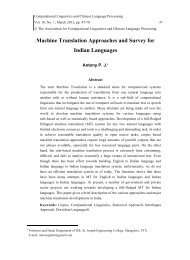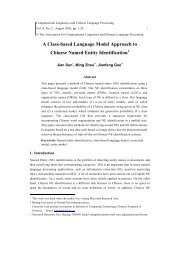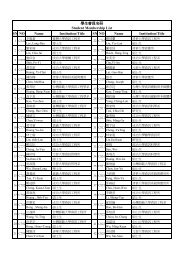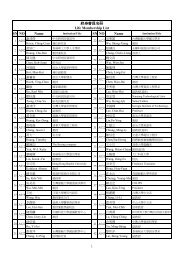Automatic Recognition of Cantonese-English Code ... - Aclclp.org.tw
Automatic Recognition of Cantonese-English Code ... - Aclclp.org.tw
Automatic Recognition of Cantonese-English Code ... - Aclclp.org.tw
You also want an ePaper? Increase the reach of your titles
YUMPU automatically turns print PDFs into web optimized ePapers that Google loves.
300 Joyce Y. C. Chan et al.<br />
7.2 Experimental Results<br />
The performance <strong>of</strong> the code-mixing speech recognition system in Figure 4 was evaluated<br />
using the CM and MC test utterances. For the CM utterances, the character accuracy was<br />
measured for the <strong>Cantonese</strong> part and the word accuracy is measured for the embedded <strong>English</strong><br />
segments. From the development data in CUMIX (see Section 3.3), the best values α and<br />
β were found to be 0.009 and 1.1 respectively. This leads to an overall accuracy <strong>of</strong> 55.1% for<br />
the development utterances.<br />
Without the use <strong>of</strong> language boundary detection, the overall recognition accuracy for CM<br />
and MC utterances were 55.3% and 50.3%, respectively, when the class-based language<br />
models CLASS_LM were used. The detailed results are given in Table 12.<br />
Table 12. <strong>Recognition</strong> accuracy without using language boundary information<br />
Overall accuracy<br />
<strong>Cantonese</strong> Character<br />
accuracy<br />
<strong>English</strong> Word accuracy<br />
CM test utterances 55.3% 56.0% 48.4%<br />
MC utterances 50.3% 50.3%<br />
We also attempted to incorporate the detected language boundaries into the recognition<br />
process. Table 13 compares the effectiveness <strong>of</strong> the <strong>tw</strong>o LBD approaches described in Section<br />
6. With LBD based on syllable bigram, the overall recognition accuracy increases from 55.3%<br />
to 57.0%. For the syllable-lattice based LBD, although the overall accuracy does not increase<br />
significantly, there is a noticeable improvement on the recognition accuracy for the <strong>English</strong><br />
words. Among the recognition errors on <strong>English</strong> words, 39.0% <strong>of</strong> them are deletion errors,<br />
while 44.2% are substitution errors. Deletion error means that no <strong>English</strong> word is found in the<br />
top-best hypothesis string. Substitution errors are mainly caused by incorrect language<br />
boundary thus the hypothesis <strong>English</strong> word and the reference <strong>English</strong> word have no or just<br />
very little overlap in time duration. For example, the word “evening” is mistakenly recognized<br />
as “even”, and “around” became “round”.<br />
It was also noted that the <strong>English</strong> word accuracy could be improved to 81.1% if the true<br />
language boundaries are used in the recognition process. It is believed that the recognition<br />
performance can be improved, when better language boundary detection algorithms become<br />
available.<br />
Table 13. <strong>Recognition</strong> accuracy attained with the incorporation <strong>of</strong> language<br />
boundary information. Only CM test utterances are used.<br />
Overall<br />
accuracy<br />
<strong>Cantonese</strong> Character<br />
accuracy<br />
<strong>English</strong> Word<br />
accuracy<br />
Without LBD 55.3% 56.0% 48.4%<br />
LBD based on syllable bigram 57.0% 57.6% 49.0%<br />
LBD based on syllable lattice 56.0% 56.4% 53.0%









